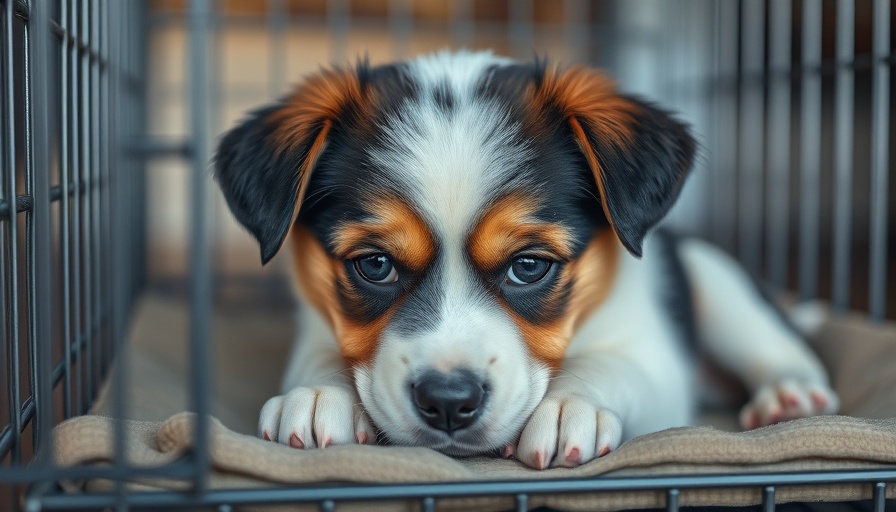
Understanding Puppy Separation Anxiety vs. Separation Distress
Before diving into techniques to help your puppy with these feelings, it's essential to understand the subtle differences between true separation anxiety and what is often referred to as separation distress. While true separation anxiety is relatively rare in young dogs, the fear and distress experienced when left alone can significantly affect both the puppy and the owner. Puppies may whine, cry, or howl when left, but these reactions don't necessarily indicate an ingrained anxiety issue—many suffer from what is better described as separation distress.
Some signs of this distress include pacing or drooling when left unattended, rather than engaging in self-destructive behaviors common in true separation anxiety. Recognizing the difference is crucial, as it directs the appropriate response for alleviating the problem and ensuring a positive emotional development for your furry friend.
Effective Crate Training Tips to Reduce Anxiety
Building a sense of security is paramount in addressing separation issues. Proper crate training can help your puppy understand that being alone is both safe and temporary. The crate should be associated with positive experiences for your puppy. Try incorporating puzzle toys or safe chew items within the crate to create an inviting environment. Establish a routine where your puppy is gradually left in the crate for short periods, progressively increasing the time as they become more comfortable.
Ensure that this is not merely a space for the puppy to be left when you are gone but a cozy den where they feel safe and can unwind. The key is to foster a sense of contentment with the crate so they see it as a refuge rather than a punishment.
Creating a Calm Home Environment
Another significant factor influencing a puppy's comfort during separation is the home environment left behind. Providing a space that is familiar and inviting—a corner of the home where the puppy frequently interacts with family—is crucial. As the article suggests, consider placing the crate or ex-pen in areas they typically enjoy teething and playing. This not only alleviates anxiety but also encourages your puppy to remain calm when left alone.
Engagement Techniques to Alleviate Distress
Puppies thrive on stimulation and interaction. Prior to leaving your puppy alone, it's beneficial to provide both mental and physical engagement to create a sense of fulfillment. Activities such as scent walks—where your puppy is encouraged to explore different scents—combined with interactive play can help to burn off excess energy. Following an energetic play session with a calming activity, such as gentle petting or a snuffle mat game, can lay the foundation for a relaxed state when independent.
Certain breed types may require more preemptive engagement due to their energy levels, so tailor the exercise routine based on your individual puppy's needs.
Building a Routine for Success
Routine is critical for helping a puppy adapt to separations. Dogs are creatures of habit; establishing a consistent pre-departure ritual can signal to them that you will return. Simple actions—like putting on your shoes or grabbing your keys—should be part of a routine that doesn't incorporate leaving the house immediately. By delaying the eventual exit, your puppy will learn to dissociate the signs with your departure.
Moreover, avoid long, dramatic farewells as they can exacerbate the stress of separation. Instead, foster a calm demeanor during your departures.
When to Seek Professional Help
If after implementing various strategies a puppy still displays signs of severe distress or begins to exhibit destructive behaviors or attempts to escape during separations, it may be necessary to contact a veterinary behaviorist or a dog training professional. Such behaviors can indicate true separation anxiety and should be resolved promptly to ensure the mental well-being of your puppy.
Ultimately, fostering a well-adjusted puppy capable of spending time alone is both beneficial for the dog-owner relationship and essential for the puppy's social development. Remember, thorough patience, persistence, and proper training techniques will yield a dog that is not only happy in your presence but also when it’s time for a little alone time.
For dog owners deeply invested in ensuring their furry friend feels loved and comforted, embracing these strategies can make a significant difference in their quality of life. Understanding canine behavior is a continuous journey, but one that's equally rewarding for both the puppy and the owner.
 Add Row
Add Row  Add
Add 




Write A Comment